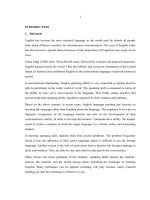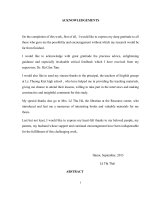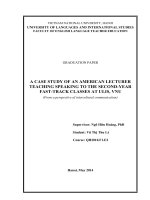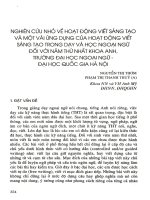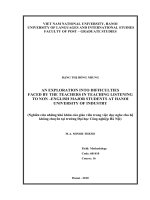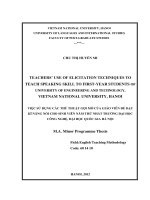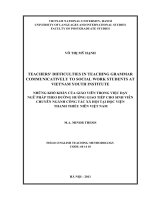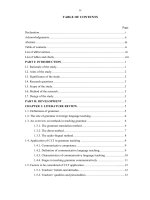KHÓ KHĂN của GIÁO VIÊN TRONG VIỆC sử DỤNG HOẠT ĐỘNG TRAO đổi THÔNG TIN để dạy kĩ NĂNG nói CHO SINH VIÊN năm NHẤT KHOA ANH đại học NGOẠI NGỮ
Bạn đang xem bản rút gọn của tài liệu. Xem và tải ngay bản đầy đủ của tài liệu tại đây (374.03 KB, 45 trang )
CHAPTER I: INTRODUCTION
1.1. Statement of the problem and the rationale for the study
It is undeniable that English is a means of international communication in the
fields of science, technology, culture, education, economy and so on. In Vietnam,
English has taken on a special significance when people are taking the modernization
and industrialization. In addition, of four English skills, speaking is considered as the
most vital part for communication. Nunan (1989, p.39) has affirmed that “mastering
the art of speaking is the single most important aspect of leaning a second foreign
language”. However, from observation, the researcher has identified the problems in
speaking ability of the first year students at FELTE- ULIS- VNU. It is the fact that the
first year students at FELTE, after five to six years learning English in high school,
still hesitate about practicing speaking English.
For the last decades, Vietnamese students usually have been taught English by
the traditional method like Grammar- Translation. This method considerably cannot
foster the speaking ability of students. According to Prator and Celce-Murcia in
Teaching English as a Second Foreign Language (1979, p. 3), the key features of the
Grammar Translation Method are as follows:
1) Classes are taught in the mother tongue, with little active use of the target
language.
2) Much vocabulary is taught in the form of lists of isolated words.
3) Long elaborate explanations of the intricacies of grammar are given.
4) Grammar provides the rules for putting words together, and instruction often
focuses on the form and inflection of words.
1
5) Reading of difficult classical texts is begun early.
6) Little attention is paid to the content of texts, which are treated as exercises in
grammatical analysis.
7) Often the only drills are exercises in translating disconnected sentences from the
target language into the mother tongue.
8) Little or no attention is given to pronunciation.
In the light of communicative approach, exploiting information- gap activities
has turned to be the useful method. Stated by Johnson and Morrow (1981, p. 62),
information gap activity is “one of the most fundamental in the whole area of
communicative teaching”. According to the knowledge about information- gap
activities provided by To Thi Thu Huong and Nguyen Thi Mai Hoa (2011), by making
use of information gap activities, the teacher will raise the student’s motivation to
speak English. Additionally, students can have more opportunities to experience the
real life situation. They are also more active and more involved in the learning process.
In brief, information- gap activities give students chances to manipulate English
appropriately not only inside but also outside the classroom.
From the researcher’s observation, however, using IGA has faced up with a lot
of difficulties. Firstly, as one of the first year students at FELTE, the researcher
witnessed the fact that students were not familiar with the use of this technique in the
class. Hence, using this technique can take a lot of time, which reduced the
effectiveness of information- gap activities. As a result, teachers have to prepare a lot
before starting an IGA. Secondly, the teachers have to use up a lot of time selecting
and creating the suitable information- gap for teaching speaking skill. As a result, it
2
can lead to more inconvenience for teachers when making lesson plan. To be more
specific, some teachers admit that they do not often use IGA in class.
Being aware of this difficulty as well as the obvious benefits of using
information gap activities, the author of this research paper was encouraged to carry
out a study on “Teachers’ difficulties in using of information-gap activities to teach
speaking skill for the first year students at FELTE- ULIS- VNU”. The author has
desire to find out the factors which lecturers consider when they select types of
information gap activities. Besides, reducing difficulties in conducting information-
gap activities in teaching speaking skill for the first year students at ED-ULIS-VNU
was also one of the main expectations of this paper. It was also estimated that basing
on exploring the difficulties of teachers when using information-gap activities, some
recommendations for solutions to select and conduct IGA can arise from.
1.2. Aims and objectives of the study
Firstly, the author aimed at finding out the factors affecting the selection to IGA
in teaching speaking skill for the first year students and difficulties in conducting
information-gap activities in teaching. Next, this study was performed to recommend
some solutions for teachers to choose appropriate IGA. To achieve these aims of the
research paper, the following research questions need to be addressed:
1. What are the factors affecting the choices of information-gap activities to teach
speaking skill as perceived by the teachers who are teaching speaking skill for the first
year students at ED-ULIS-VNU?
2. What are the difficulties in selecting and conducting information- gap activities to
teach speaking skill as perceived by the teachers who are teaching speaking skill for
the first year students at ED-ULIS-VNU?
3. What are the solutions to the problems of the teachers in conducting IGA to teach
speaking skill as perceived by the teachers who are teaching speaking skill for the first
year students at ED-ULIS-VNU?
3
1.3. Significance of the study
The first and foremost significance of this study is that would provide lecturers
of the FELTE with a closer look at the conduct of the information gap activities from
the aspect of difficulties. Hence, they can equip by themselves with the problems in
use of IGA. Moreover, the findings of the research will supply some hefpful solutions
for teachers to reach better use of IGA to teach speaking skill. In terms of other
researchers who share the same topics, the study can perform as reliable sources for
their further studies in the future.
1.4. Scope of the study
Due to limited time and experience, this study focused mainly on the teacher’s
difficulties in selecting and adapting information-gap activities in teaching speaking
skill. Particularly, this research paper was only made on the aspect of teachers at
FLETE- ULIS- VNU. In fact, this would be more convenient and manageable for the
author who is the last year student at this university. Finally, this graduation paper did
not focus on teaching all four skills but only speaking skill for the first year students.
1.5. Organization
The paper consists of five main parts as follows:
Chapter 1-Introduction states the rationale for the study, aims and research questions,
scope, significance and organization of the study.
Chapter 2- Literature review aims to supply theoretical background about speaking
skill and information-gap activities when teaching speaking skill in the light of
communicative approach.
Chapter 3- Methodology- expresses the methods which are applied to find out the
necessary for the study. In specific, it consists of selection of subjects, research
approach and procedures of data collection and data analysis.
4
Chapter 4- Results and analysis is the chapter of data analysis. In this chapter, the
results will be analyzed in detailed to find out the answers for the above research
questions.
Chapter 5- Conclusions mention the major findings and contributions of the research
study. Besides, it also refers to the limitations of the paper. Finally, in terms of further
studies, this chaper supplies some suggestions for other research in the future.
5
CHAPTER 2: LITERATURE REVIEW
2.1. An overview of speaking skill
2.1.1. The nature of speaking
It is a common knowledge that speaking is the easiest and most effective means
of communication to help people understand each other. According to different
linguists, speaking is presented with different definitions.
Introduced by Celce- Murica, Dornyei and Thurrell (1995, p. 10- 24), speaking
refers to 5 types of competence including: grammatical competence, strategic
competence, strategic competence, socio- cultural competence and discourse
competence. In other words, learning to speak a foreign language requires more than
knowing language features, its grammatical and semantic rules. Learners need to equip
the knowledge of how native speakers use the language in socially constructed
interactions or what is expected socially and culturally by users of target language.
Based on the opinion of Byrne (1998, p.8), speaking is considered as “a two
way process between speaker and listener, involves the productive skill of speaking
and the receptive skill of understanding”. Hence, in the process of speaking, both
speaker and listener play a positive function: the speaker has to encode the message to
be understood in an appropriate language, and the listener has to decode the message.
This view is also shared by Nunan (2003, p.48) who agrees with Byrne at the point
that speaking is a productive oral skill and it consists of producing systematic verbal
utterances to convey meaning.
Scott (1981) believed that in speaking activity, both participants have to play
the role of speaker and listener alternatively when they react to the information they
get and make contribution to it. This definition helps to clarify the role of participants
when taking part in speaking activity. Speaking activity can not be informed when
there is only one person to hear and the other say to the whole of activity.
Finally, the researcher finds the definition of Chaney (1998, p.13) quite easy
to understand and follow. This definition is also closest to the researcher’s perception
6
of speaking skill. He affirms that speaking is “the process of building and sharing
meaning through the use of verbal and non-verbal symbols, in a variety of contexts.”
In other words, speaking skill is one of methods people use to communicate to each
other.
2.1.2. Teaching speaking skill in Communicative Language Teaching
2.1.2.1. Communicative Language Teaching
The concept of Communicative Language Teaching (CLT) is introduced first
by Hymes in 1972 as “communicative competences”.
Different from the traditional methods, CLT aims to promote the ability of
learner for effective communication. According to Ellis (1993, p. 91), communicative
language teaching is designed to “provide learners opportunities for communicating in
the second language.” In regard to CLT, Revell (1991, p. 5) claims that “ theories of
communicative competence imply that teachers must do more than just supply learners
with a number of language structures to manipulate.” In other words, teachers have to
do more to motivate students involved in communicating. This opinion, evaluated by
the researcher, reflected adequately the differences between CLT and the traditional
methods. Based on the opinion of Pattison (1989, p.19), teachers must do to develop
“the learner’s communicative competence and performance”. As Brown (1994,
p.226) describes, communicative approach focuses on “speaking and listening skill, on
writing for specific communicative purposes, and on authentic reading texts.”
2.1.2.2 Teaching speaking skill in CLT
Speaking skill should be taught in language classroom. However, as written by
To Thi Thu Huong (2006), speaking as well as listening skill is ignored with
traditional methods which focus mainly on reading and writing. Meanwhile, people
speak everyday much more than they write. Byrne (1980, p.9) believed that “the main
goal in teaching the productive skill will be oral fluency which can be defied as the
ability to express oneself intelligibly, reasonably, accurately and without too much
hesitation”. With CLT, according to Scott (1981, p.7), “the communicative approach
7
makes sure that the interactions which take place in classroom are replication of, or
necessary prerequisites for a communication operation”. In addition, Abu Sharbain
(2009, p.23) added that “the communicative approach calls for increasing the
students’ talking time and decreasing the teacher’s talking time. This comes as a
result of providing the learners with opportunities to speak through cooperative
independent activities”. Hence, from above explanations, the researchers make a
conclusion that teaching speaking skill in CLT will lead to create an active and
communicative activities for students.
2.1.3. The roles of teachers in CLT
In traditional method, teacher often takes the central model and dominates all the
time in the class. Meanwhile, teachers in communicative classrooms will find
themselves talking less and listening more- becoming more active facilitators of their
students; learning (Larsen- Freeman, 1986). Additionally, claimed by Johnson and
Morrow (1981, p.71), teacher , “instead of being the person who provides prompt that
trigger utterance of a certain structure from the students”, “now sets up the
conditions for communication to take place”. In other words, teacher now does not
take only single role of model but more than that. Breen and Candlin (1980)
summarized three main roles of teachers in communicative classroom as “facilitator”,
“participant” and “observer and learner”. Also giving support for this idea, Byrne
(1980, p.1) emphasized that “the first task of a teacher is to create the best conditions
for learning.”
2.1.4. Principles of teaching speaking skill
In regard to this content, Nunan (2003) and Kayi (2006) suggest some
principles that helps teacher to create activity for teaching speaking skill. There are
some prominent principles used here for basic background as following:
1. The teachers should differentiate between second language and foreign
language
2. Fluency and Accuracy should be given to students to practice.
8
3. The teachers should provide opportunity for students to talk by using group-
work and pair- work and limit teachers’ talk.
4. Speaking tasks should be planned to involve negotiation of meaning.
5. The teachers should design activities involving guidance and practice in
transactional and interactional speaking.
6. Questions delivered by teachers should motivate students to talk more.
7. Teachers should not correct mistakes in pronunciation so often while they are
speaking.
8. The teachers should reduce teacher speaking time in class while increasing
student speaking time. Step back and observe students.
In brief, teachers should well prepare for mixed classes with a variety of levels.
Teachers should create a communication environment for students to practice speaking
skill.
2. 1. 5. Problems in teaching speaking skill
However, problems in teaching speaking skill are unavoidable. There are some
practical problems as presented by Ur, P (1996, p.21):
- “Inhibition”: Speaking requires speaker’s exposure to an audience, at least.
Learners can be afraid to speak in front of whole class. They will be worried to lose
their face when making mistakes before their friends.
- “Nothing to say”: Some students complain that they have nothing to say. The
reason is that they have no idea about the target topic or vocabulary of that
topic.
- “Low or uneven participation”: This happens when students work in groups.
When working with many people, the speaking time of each one will be
decreased. Leaders may dominate discussion. Meanwhile, others say very little
or even not at all.
- “Mother tongue use”: All the students share the same mother tongue. As
consequences, they may use mother tongue to express their ideas because it is
9
easier and more natural. Some students can fell less “exposed” when they use
mother tongue.
2.1.6. Suggested solutions to problems in teaching speaking skill
To solve the problem of teaching speaking skill, Ur (1996, p.22) suggested some
solutions as follows:
- “Use group work”: This solution will be suitable for problems of inhibition of
students. They can work in small group in stead of standing in front of whole
class.
- “Base the activity on easy language”: The level for a discussion should be
lower so that it should be easily recalled and produced by participants. Hence,
teachers should review vocabulary before the activity starts.
- “Make a careful choice of topic and task to stimulate interest”: Activity with
interesting topic will motivate students to talk more
- “Give some instructions or training in discussion skills”: Teacher should
include instruction when introducing the task which is based on discussion.
- “Keep students speaking the target language”: There are some ways for
teachers to keep students speaking the target language. Teachers can stay there
besides students as much as possible keeping them from substitute for nagging.
2.2. An overview of information gap activities
2.2.1. The nature of IGA
Cited in Longman Dictionary of Language Teaching and Applied Linguistic
by Richards, Platt and Weber (1979, p.179), “information gap (in communication
between two or more people) is a situation where information is known by only some
of those present.” In the same opinion, Richard (2005, p.17) believed that an
important aspect of communication in CLT is the notion of information gap. The
existence of information gap refers to the situation that people communicate to get
information that they do not possess.
10
According to Harmer (1989, p.88), information gap is “where two speakers have
different parts of information making up a whole. Because they have different
information, there is a gap between them”.
Johnson and Morrow (1981, p.62) proposed that an information gap means “one
student must be in a position to tell another something that the second student does not
already know”.
Information gap, based on the definition given by Harmer (1991, p.48), is “a gap
between the two persons in the information they possess, and the conversation helps to
close that gap so that now both speakers have the same situation”.
From the previous explanation, the researcher concludes that information gap
means that there is a gap of information between speakers and listener. Also, that gap
is also one of the main reasons they need to communicate to close it. Activities
designed based on information gap, As Scrivener (1994, p.62) explained, is to “get
learners to use the language they are learning to interact in realistic and meaningful
ways, usually involving exchanges of information”.
2.2.2. Types of IGA
In fact, the concept of information gap is quite broad. As a consequence, each
linguist provides different categorization of information gap activities. They are as
following:
Norman and Levihn (1986, p.100) categorized information into two types as
“puzzle form” and “personal questionnaire”.
Doff (1989) agreed at certain extend when he claimed that information gap
activity includes “guessing games, IGA for pair work and exchange personal IGA”.
Littelewood (1981) divided IGA into two kinds that are “sharing information
with restricted cooperation” and “sharing information with unrestricted cooperation”.
According to Long (1990), IGA can be two kinds: “supplied to the learner”
and “supplied by the learner”.
11
Based on the fact that one or both learners have information to share, Ellis
(1999) divided IGA into “one-way activities” and “two-way activities.”
However, the researcher finds the categorization of Doff easiest to follow.
This research paper will be based on Doff’s way to divide the IGA. For better
understanding of this theory, the researcher tabled types of IGA as following:
Table 1: Types of information gap activities
2.2.2.1. Guessing game
According to Ur (1981), “a guessing game is the process of discovery by one
individual or group of an item of information known to another, with some on its
transmission”. In guessing game, students are forced to ask question to find the
information about the things. There are existence of “knower” and “guesser” in this
type of IGA. In the light of Doff’s view, guessing games consist of the following
popular types:
a. Guessing the picture
In this type, teacher prepares a set of flashcards with simple pictures. The teacher
will call one student to choose one card, but does not show to class. Class has to ask
questions to the student to know what the picture is.
For examples:
T: Guess how I went to A
Ss: Did you go by car?
12
Information gap
activities
Guessing games
Information gap
excises
Exchanging personal
information
Did you go by bus?
Did you walk?
b. Guess the sentence
The teacher writes a sentence on a piece of card. The sentence is hidden, but the
basic structure is written on the board to provide context for the guessing. For
example:
I went to do Then students ask questions to guess the right
sentence.
Ss: Did you go to the park?
Did you go to school?
Did you go to stadium?
c. Guess famous people
One student pretends to be a famous person. The other students make questions to
guess who that famous person is. For example:
Are you Vietnamese or English?
Are you a singer?
Are you a actress?
d. Mime
The teacher calls one student to the board and gives her a sentence. Student will
see and describe by simple activity. The other will try to guess the situation by asking
questions.
e. What’s my line?
One student chooses a job, and mimes a typical activity related to the job. The
other students can ask questions about the activity or the job, For example: Were you
reading something?
Were you digging?
f. What and where
13
Two students are sent out of the room while other students hide an object. Two
students come back and give questions to guess what the object is. The questions can
be like “Is it made of wood?” or “Is it a pen?” or “Is it high or low?”
2.2.2.2. Information gap exercises
Different from guessing game, information gap exercises aimed at real communicative
practice.
Presented by Doff (1989), these exercises are usually designed form pair work and can
be done in various ways as followings:
- One student has some information; the others have to find out by asking
questions.
- The two students in each pair are given different information, and they have to
communicate to find out.
- One student has information, and tells it to other students.
The researcher presented Doff’s opinion in the form of table for better comprehension:
Table 2: Types of information gap exercises
Completing
the grid
Detecting
differences
Jigsaw activities Shopping list
Students may
work in pair or in
group. One
student has an
empty grid and
other has the text.
Student with
blank grid has to
ask questions to
find out the
information
Two students are
given two pictures.
Except from some
differences, two
pictures are quite
similar. Students
have to find out the
differences by
describing the
picture to their
friends
Each student has one
or a few pieces of the
“puzzle”, and they
must cooperate to fit
all the pieces into a
whole picture. The
“puzzle” can exist in
many forms. It can
be sentences form a
story or photos to tell
a story
Students work in
pair in which one is
customer while
other student is a
shop assistant with
a list of items in the
shop and their
prices. They
communicate to buy
and sell things
14
2.2.2.3. Exchanging personal information activities
In Doff’s opinion, this kind of information gap is considered as one of the easiest
and most interesting form. Taking part in this type, students are motivated to talk about
their interests, their own lives, and experiences. A typical model is your favorite is or
Find some one who. Students walk around and ask their friends if they like or dislike
something given in the questionnaire.
2.2.3. Benefits of using IGA in teaching speaking skill.
According to Ur (1996, p.120), a successful speaking activity happens when
+ Learners talk a lot: As much as possible of the period of time spent for the activity is
occupied by learner talk.
+ Participation is even: Not only the talkative participants of classroom take part in
speaking activity. All students can get a chance to speak. “Even” explains that all
contributions are reasonably evenly spread.
+ Motivation is high: Students want to join in speaking activity because they have
something new to share or they want to have a say in completing a task.
+ Language is of an acceptable level: The language of students is comprehensible,
relevant and easy to understand.
Related to the benefits to motivate students to talk a lot, Adrian Doff (1988) has the
same opinion when he says that an information gap activity “provides intensive and
interesting language practice. Although the exercises are quite controlled and use
simple language, the students are really exchanging information and using language
communicatively”.
David Norman, Ulf Levihn and Jan Ander Hedenquist (1986, p.100), discussing
about students’ participation in IGA, affirms that “IGA ensure the classroom activities
involve some exchange of information to more complex exchanges which involve not
only information but ideas and attitudes. They are important because they are a step
away from formal practice towards an activity which more closely mirrors the use of
language outside the classroom”.
15
According to Nunan, D. (1989, p.122), “information gap can, in fact, act as a
nucleus around which a range if other tasks and exercise types can be constructed”.
2.2.4. Factors affecting the choice of IGA
In order to choose suitable IGA, teachers should consider some factors. Based
on the graduation paper completed by Nguyen Thi Thu Trang from 051E10, there are
four factors affecting the choice of IGA. The factors are listed as the students’
language level, the time allowance, the language focus and the necessary teaching
aids.
Firstly, students’ language level is the most significant factor. If the activity is
above their level, student will find too difficult to complete. Then, it will waste of time
with no effectiveness.
Secondly, the chosen information gap activities have to be suitable to objectives of the
lesson. Hence, the objectives of the lesson have to be clarified right from the start of
the lesson.
Thirdly, time allowance should be considered, too. For in stance, an
information gap activity set for warming activity should be less than ten minutes.
Meanwhile, fifteen to twenty can be spent for an information gap activity in order to
practice newly presented language items.
Lastly, teaching aids also need paying attention to. If it is difficult to find the
materials for an information activity, IGA should be omitted or replaced. Hence,
during the preparation, the teacher should assure that the aids are available, visible and
attractively presented so that students can be motivated.
2.2.5. Typical procedure to conduct an IGA.
Levihn and Hendenquist (1986, p.101) provide 5 steps to conduct an IGA
- Step 1: Class are divided in to pairs
- Step 2: Each student in each pair is given the half of IGA. The information
given to students should include the instruction. Giving instruction that they are
not allowed to look at their partner’s information.
16
- Step 3: It is time for preparation silently
- Step 4: Students do the activity.
- Step 5: There is more than one pair “performs” before the class. After each
“performance”, the pair with the same content is invited to give comment. Both
teacher and students make comments on how the language can be improved.
2.2.6. The teacher’s role in teaching IGA activities
In IGA activities, teachers have to take many different roles. The following points
clarify the roles of teacher in teaching IGA activities.
The first role of teacher is known as “designer or organizer”. According to Brown
(2001, p. 167), teacher has to “keep the learning process flowing smoothly and
efficiently”. In addition, Byrne (1991, p.13) considers teachers as an actor when
supposing that the teacher “will have to play different roles at their learners”. In other
words, teacher has to be flexible to require different demand of students. However,
“the most effective activities can be made almost useless if the teacher does not
organize them properly” (Harmer, 1991, p.235)
Secondly, teacher is also known as participant and prompter. Liao (2008. p.17)
believed that “there is no reason why the teacher should not participate as an equal in
the activity”. Teacher can offer his information at the same time introduce and present
new language. Harmer (2001) points out that the teacher also needs to let students
overcome a difficult situation.
Finally, teacher can take the role of investigator and assessor. According to
Harmer (1991), as an investigator, the teacher has a desire to develop their skills and
language learning. In addition, as an assessor, teacher will give commence on
students’ performance in the activities, then evaluate and adjust teaching target to the
real situations.
In brief, this point of view about the roles of teachers stands at the same ground
as the mentioned literature review. The researcher has concluded that the teachers less
17
dominate the time in the class compared to traditional methods. However, it does not
mean that their roles become less important than in traditional activities.
CHAPTER 3: METHODOLOGY
18
In the previous chapter, the researcher presented an overview about the
literature review setting theoretical foundation for the study. In this chapter, the
methodology utilized to answer the research questions would be revealed. The
participants, the instruments to collect data and the procedure to collect and analyze
data would be also indicated.
3.1. Research design
To find the answers for three questions raised in the introduction, the researcher
adopted a combination of the quantitative and qualitative approach. By adopting
quantitative method, the researcher can improve the level of reliabilility when
performing mass survey according to Baseley (1970, as well as “arrives at more
objective conclusions”, and “eliminates or minimizes subjectivity of judgment”
(Kealey & Protheroe, 1996, 141- 165). However, it has restricted the power of
explanation. Combined with qualitative method, including teacher interviews, the data
will be improved. The qualitative approach, according to Burnes (1999, p.22) cited in
the study implemented by Ms. Tran Thi Hieu Thuy, is “to draw conclusions from the
data collected to make sense of how human behaviors, situations and experiences
construct realities”. These instruments were made use of to reveal what the teachers
really thought about information gap and the difficulties they faced up with in reality.
In addition, the scale of this study was quite small. Hence, it would be better if an
insightful investigation can be conducted. A qualitative approach can promise an in-
depth understanding. Via combining qualitative and quantitative methods, the
researcher can reach the objectives. Consequently, the researcher can get the deep
understanding about the factors as well as the realities in conducting IGA to teach
speaking skill with the objective values and variable control. It is expected that the
relationship between teachers’ self-report and their actual behavior in adapting IGA in
classes will be examined.
3. 2. Participants
19
3.2.1. Population
Since the study involving in teachers’ difficulties with information gap
activities, the role of teachers is undeniable. Meanwhile, the research paper
investigates the problems when lecturers teach speaking skill for the first year
students. As a result, the participants are expected to be the teachers who are teaching
the first year students at Faculty of English language teacher education. They have had
experience in teaching speaking skill for the first year students at FELTE- ULIS-
VNU. It means that they have faced up with many problems during their time of
teaching speaking skill. Additionally, most of teachers acquire the MA degree in
TESOL and others are pursuing an MA course in TESOL at CFL- VNU.
3.2.2. Sampling method
In the light of simple random sampling, introduced by Gary (1990, p. 27),
which is “All members of the study population are either physically presented or
listed, and the members are selected at random until a previously specified number of
members or unit has been selected”, the researcher was capable of achieving
understanding into the topic investigated. The informants included 20 teachers who are
teaching the first year students. They were picked up randomly from the list of all
teachers at English I Division, FELTE- ULIS- VNU.
3.3. Data collection instruments
3.3.1. Questionnaires
To obtain reliable and valid result, the survey questionnaire was adopted as the
main source of data. According to Brown (2001, p.6) “questionnaires are any written
instruments that present respondents with a series of questions or statements to which
they react either by writing out their answers or selecting from among existing
answers”. In theory, questionnaires are both time saving and labour saving for the
researcher. According to Robinson (1991), the procedures for data collection are
“manageable, cost effective in terms of time and money, and appropriate for the
20
situation”. In other words, with a relatively short period of time, the researcher can
deliver the survey to a larger number of participants than other methods. In addition, as
Peterson (2001) confirms, the obtained data, especially from closed questions, is
relatively easy to analyze. Those advantages of questionnaires led the researchers to
make use of it as one important instrument for the research.
The questionnaire delivered to the teachers consists of 20 items (mostly close-
ended) organized into 4 sections. Section 1 with 5 questions, aims to collect general
information and categorize the respondents such as age, gender, experience in
teaching speaking skill for the first year students at FELTE- ULIS-VNU. Sections 2
includes 5 questions about information on teachers’ understanding IGA. Section 3
with 9 questions continues to explore experiences of lecturers in choosing and
practicing information gap activities to teach speaking skill. Section 4 with 1 question
aims to recommend the solutions for the problems incited in above sections. Details on
teacher questionnaires can be found in Appendix 1.
3.3.2. Interviews
Besides questionnaires, the researcher used semi- structured interviews as a
data collection instrument for obtaining further information on the issues of the study.
“As interview are interactive, the researcher can elicit additional data if initial
answers are vague, incomplete, off-topic or not specific enough” (Mackey and M.
Grass, 2005). This interview was prepared in advance to get in- depth information
about the difficulties and motivate the participants to provide suggestions for solving
the problems. Dowsett (1986, p.53) confirms that a semi- structured interview gives
the interviewee a degree of power and control over the course of the interview; it also
gives the interviewer a greater deal of flexibility. Together with note- taking, the
researcher would get information from interview by recording for checking and
revising later. Surveyed teachers were invited to participate in the interview which
lasted within 15 minutes each.
21
3.3.3. Observation
Because the research paper is on a practical issue, classroom observation is
regarded as an effective tool to verify the results obtained through questionnaires and
interviews. According to Cohen, Manion and Morrison (2000, p.51) “observational
data are attractive as they afford the researcher the opportunity to gather ‘live’ data
from ‘live’ situations”. With the use of “over time and repeated observation, the
researcher can gain a deeper and more multilayered understanding of the participants
and their content” (Mackey and Gass, 2005, p. 176). The researcher completed
collected data by filling up the observation checklist during observation. The
observation checklist aimed to clarify the procedure of an IGA and students’
involvement in one IGA.
3.4. Data collection procedure
The data collection procedure includes two main stages:
3.4.1. Collecting data
Step 1: In this stage, the researcher prepared the questionnaire and the interview
schedule. Firstly, these questionnaires were analyzed, revised to avoid the case that the
questions would not be comprehensible and the answers would be too difficult to be
analyzed. After that, they would be piloted to one participant so that the researcher
could identify additional problems listed as ambiguous or difficult, repetitive or not
clear enough items. Afterwards, the research could add or omit to give the suitable
questionnaires and interview questions. These questionnaires and interview questions
were then completed before delivered to the target population.
Step 2: The questionnaires were sent to 20 teachers at English I Division, FELTE-
ULIS- VNU. Before distributing the questionnaires, the researcher had to acquire
permission of teachers at FELTE. In email, the researcher gave the instructions to
participants clearly and informatively so that valid data was collected. Should there be
22
further inquires, informants were encouraged to contact the research via email or
mobiphone.
It should be noted that, there were 20 survey questionnaires sent to informants.
Only 15 lecturers sent their answers back. Consequently, the number of informants of
this study has shrinked into 15 insead of 20 as the previous plan.
Step 2: Afterwards, the interviews with teachers were conducted. While
interviewing, the researcher tried best to take notes and tape-record the content under
the interviewees’ permission. It should be reported that there was a shrink of
interviewed informants. Because of time constraint and the difficulties that the high
school for practicum was at a great distance, the researcher could not interview with 5
informants as planned. Hence, the number of participants in interview reduced to 2
people. In addition, for more convenient analysis data and further reference, the
researcher coded the two interviewees as interviewee A and interviewee B according
to the time they were interviewed.
Step 3: Finally, classroom observation was conducted. After noticing the confronts
between the speaking schedule of the first year students and the researcher’s schedule,
the researcher asked for an observation in one left available class. To be more specific,
011.E5 was the class that did not shift to presentation and case study yet.
During the observation, the researcher played the role as a non-participant observer
who performed two main tasks including observing and completing the checklists.
When observing the speaking period with using of IGA in that period, the researcher
made note-taking and recorded from classroom observation. The information would be
analyzed for findings and analysis later.
3.4.2. Processing data
23
After having administered the questionnaires, interviews as well as observation, the
researcher processed the results of the questionnaires and completed the print version
of the interviews to make it convenient for later analysis and quoting. Noticeably,
detecting of significant points was taken to ensure the reliability and precision of the
responses of teachers.
3.5. Data analysis methods and procedures
First of all, the participants would be described according to general collected
information from questionnaires. Then, the collected data was classified with the three
research questions. Afterwards, each type of collected data would be analyzed into
three different ways.
For the first research question, the researcher would gather all the information from
questionnaires and interviews relating to the choice of teachers when making decision
about types of information gap activities to teach speaking skill. Other answers
contributed by teachers while being interviewed were also judged. The results,
afterwards, would be classified to be arranged in order of importance level. Then, it
was expected to compare the results with literature review to give conclusion for the
first research question.
To the second question about difficulties of teacher, the information was collected
mainly from section 3 in questionnaires, and interviews. The responses of participants
were calculated and transferred into numerical form, which was the percentage of
participants who shared similar ideas or their average rating. The results were then
tabled and charted for clearer understanding and better synthesis. Next, in the light of
literature review, the researcher would consider how the literature was applied in the
environment of FELTE- ULIS- VNU. Afterward, the researcher would compare the
difficulties of participants with the reality when observing her class to give judgement
if the teacher really got trouble with that aspect.
24
Finally, with the intention to suggest some solutions for the problems of the
teachers, the researcher arranged teachers’ answers according to a five-point scale,
corresponded with a strong agreement with each statement given in the questionnaire.
The level of agreement gradually descends to strongly disagreement answer. The
answers to the last question were synthesized and summarized. To be the same as two
previous questions, the answer to this question, based on literature review, would be
discussed to see which solutions came into practice in the settings of FELTE- ULIS-
VNU.
Summary
The chapter has shown the methodology applied to perform this study. Data was
obtained from lecturers from FELTE, ULIS, VNU with the utilization of
questionnaires and interviews and observation. The data was then analyzed carefully
to ensure the validity and reliability of the research.
CHAPTER 4: RESULTS AND DISCUSSIONS
25
